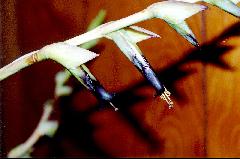
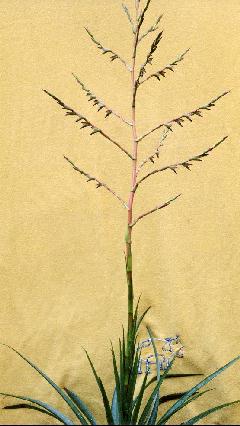
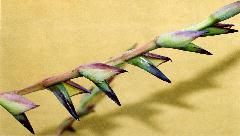
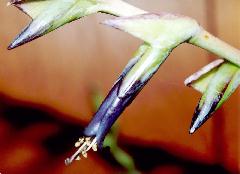
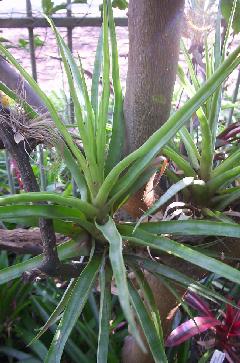
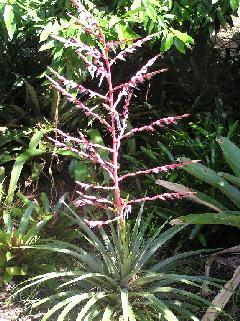
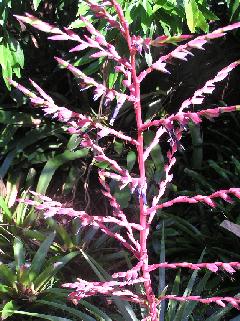
Tillandsia secunda var. major Rauh Trop. Subtrop. Pflanzenwelt 21:28-34 1977 (Latin diagnosis 50:36. 1984)
Plant stemless, flowering to 4m(!) high, leaf rosette 1.5m
Leaf sheath 20-30cm long, to 15cm wide, both sides leathery brown.
Blade rigid, erect, sub-lingulate, acuminate, to 1.2m long, next to sheath 10-15cm wide, topside green and red flecked, almost glabrous, scattered small scales, underneath clearly nerved and dense grey lepidote.
Scape to 5cm thick at base, to 1.5m long, densely covered with leaf-like scape bracts.
Inflorescence 1.5-2.5m long, laxly pyramidal, to1.5m wide, laxly tri to quadripinnate.
Side Spikes numerous, the bottom one (including the top spike) to 80cm long, horizontal or bent downwards, with a thick, edged, carmine red rhachis.
Top spike to 50cm long, with long, bracted sterile basal section.
Floral bracts secund, to 3.5cm long, strongly nerved, ecarinate, carmine red.
Sepals 4-5cm long, ecarinate, acuminate, weakly nerved, green at base, violet at top.
Petals 5-8(-10)cm long, violet then whitish at base, with reflexed tip.
Stamens and Stigma widely exceed.
Capsule to 6cm long, hanging down.
Habitat near Ona (Prov. Cuenca)Ecuador, on dry rocky slopes, 2100m.
Holotype Rauh No. 35120 (HEID)
8. Tillandsia secunda H. B. K., 1816 (Nova Species et Genera vol. 1) p. 294. Fig. 64
Detail from Gilmartin, Brom of Ecuador, 1972
Plant ca. 120 cm tall by ca. 75 cm in diameter;
Leaves ca. 50 cm long, blades 4.0-6.0 cm wide, triangular, sheath ca. 15 cm long;
Scape ca. 110 cm long with inflorescence;
Scape Bracts 12-30 cm long, imbricate, erect to spreading;
Inflorescence ca. 50 cm long with ca. 20 spikes, bipin¬nate, main rhachis dark red; Primary Bracts 3.0-8.0 cm long, apex acute;
Spikes 12-35 cm long by 1.5-2.0 cm wide at anthesis exclusive of petals, spreading out at nearly right angles with main axis, stipe 7-13 cm long with usually 3 or more sterile bracts;
Floral Bracts 2.7-3.0 cm long by ca. 1.0 cm wide, erect to spreading turning secund at anthesis, ecarinate, nerved, apex acute and twisted out exposing calyx, not imbricate;
Sepals ca. 2.7 cm long, nerved, ecarinate, equally short connate;
Petals ca. 4.5 cm long, with stamens exserted or not;
Capsules ca. 3.5 cm long, distance between flowers ca. 1.0 cm, in flower around September.
MATERIAL EXAMINED: Humboldt 3094 (B, TYPE; US, photo) Guaylla¬bamba, Prov. Pichincha, ca. 2100 m; Andre 2448 in part (GH) Rio Pisque, Prov. Pichincha, June 1876; Asplund 8154 (US) valley of Rio Pillaro between Ambato and Pillaro, on cliffs, Prov. Tungurahua, Aug. 1939; Fagerlind and Wibom 1043 (US) just west of Ambato, valley of Rio Ambato, Prov. Tungurahua, 2 Nov. 1952; Rauh, Hirsch E244 (US) Rio Apagio, Prov. (? ), 3400 m, 7 Sept. 1954; Acosta Solis 14872 (F) Prov. Imbabura; Acosta Solis 14874 (F) Paman, Prov. Imbabura, ca. 2000-1700 m; AJG 1083 (US) km 32 Quito-Otavalo, Prov. Pichincha, 7 Aug. 1965; AJG 1082 km 32 Quito-Ota¬valo, Prov. Pichincha, 7 Aug. 1965; AJG 1091 (US) barranco, terrestrial, moderately common, association with grasses, composites and Ericaceae, km 38 Ambato-Banos, Prov. Tungurahua, 2300 m, 7 Aug. 1965; AJG 1092 (US) moderately common, km 38 Ambato-Banos, terrestrial, Prov. Tungurahua, 2300 m, 7 Aug. 1965; AJG 1157 (US) moderately common, terrestrial, dry grassy slopes, km 110 Loja-Cuenca, Prov. Azuay, 2100 m, 12 Aug. 1965, Acosta Solis 6233 (F) forest of El Olivo, Prov. Bolivar, ca. 2800 m, 7 Oct. 1943; Acosta Solis 6848 (F) Pucara de Telimbela, Prov. Bolivar, 2600-3000 m, 18 Nov. 1943.
NOTES: The degree of secund disposition of flowers is quite variable. In some specimens nearly all the flowers are secund, in others very few spikes have secund flowers. Some are secund in bud, others are not. Specimen AJG 1157 has dimorphic flowers. Some flowers have the stamens exserted with the stigma not at all exserted, while upon the same specimen are flowers with the stigma exserted and the stamens included within the corolla, flowers perhaps being at different stages of maturity.
Tillandsia secunda H. B. K. by W Rauh in Trop Subtrop Pflanz. 21: 28-34. 1977
Translated by Butcher
Another representative of Ecuadorian Tillandsias with hanging flowers that are wide spread in central and south Ecuador, growing abundantly in large stands on rocky stones in dry valleys and in semi humid bush land from 2000 to 3400 m, you find T. secunda, already described by Humboldt, Bonpland and Knuth 1816 in Nov Spec. et Genera (Vol 1, p. 209), under its collection Nr. 3094 from the area around Guayallabamba North of Quito (Prov. Pichincha). This has been found by many collectors at different other places since then ( A. J. Gilmartin, 1972, p. 165) and shows, not needing reminders from literature, an astonishing diversity regarding big, branching and total growth form. Gilmartin indicates the variability alone concerning the position of the flowers: “The degree of disposition of flowers is quite variable. In so many specimens nearly all flowers are secund, in others very few spikes have secund flowers, some are secund in bud, others are not. Specimen AJG 1157 has dimorphic flowers. Some of the flowers have stamens exserted, while upon the seed specimen are flowers with the stigma exserted and the stamens included with the corolla " (p 166). This difference is, however, quite insignificant. They are more remarkable after the outstanding listed differences, which justify the installation the two new varieties major and vivipara.
First of all some remarks on the type T. secunda H. B. K. var. secunda itself: Plant flowering only 1,2 m high. Leaves long-triangular acuminate, to 50 cm long, weakly lepidote. Inflorescence bipinnate, with about twenty, 7-35 cm long, with stemmed spikes horizontal spreading from the axis. Scape 7-13 cm long, with bracts. Flowers blue-violet to 4,5 cm long.
On the way from Cuenca, we collected near Ona plants three times as large as the type,. tri - to quadripinnate inflorescence and to 8 cm long flowers. These were not rare giant specimens and will be described as var. major Rauh var. nov.:
Plant stemless, flowering to 4 m (!) high. Rosettes to 1,5 m high, reminiscent of the Amaryllidaceae Fourcraea.
Sheaths 20-30 cm long, to 15 cm wide, both sides leather-brown.
Blades tightly erect, sublingulate, acuminate, to 1,2 m long, above the sheath 10-15 cm wide, upper side green and red stained, almost glabrous, small scattered scales, underneath clearly nerved and densely grey lepidote.
Scape at the base to 5 cm thick, to 1,5 m long, densely covered by subfoliate scape bracts.
Inflorescence 1,5 to 2,5 m long, lax pyramid, to 1,5 m wide, lax tri - to quadripinnate (fig. 15, left). Side-branches of first order numerous, basal ones (including the end spike) to 80 cm long, horizontal from the thick, angular, crimson axis spreading or bent overganging. End spike to 50 cm long, with long, bracted, sterile basal section, (fig., 15). Floral bracts secund, to 3,5 cm long, strongly nerved, ecarinate, crimson, (fig. 15a).
Sepals 4-5 cm long, ecarinate, acuminate, weakly nerved, green at the base, against the tip violet.
Petals 5-8 (- 10) cm long, violet, whitish towards the base, with bent back tips, exceeded by the stamens and style.
Fruit to 6 cm long, strongly hanging downwards ( fig. 15 a).
Habitat: near Ona (Prov). Cuenca, dry rocky hillside, 2100 m,
Holotypus: Rauh, Collection Nr. 35 120, in HEID.
Fig. 16 shows a plant (Rauh Coll. Nr. 35 085), collected between Cuenca and Sta. Isabel and up to 3 m high It seems between the var. secunda and var. major. The question of whether this was suitable examination material is not clear, is it a stable normally large form or a polyploid Giant form?
In addition we collected at the type locality of Guayallabamba a variety that will be called vivipara Rauh nov. var.
The size is about the same as the type, with a bipinnate inflorescence (fig. 17), but differs from this by having an extensive, vegetative increase with the help of offsets. These appear on the plant in large numbers, as well as in the axilles of the subfoliate scape bracts (fig. 17, left), as well as in the axilles of the sterile bracts of the stem-like section of the spike (fig. 17, middle, B). Also the permanent vegetative permanent spike tips are inclined to proliferation and grow, similar to Tillandsia latifolia, to new plants ( fig. 17, right, B). Despite its extensive vegetative increase, the plants have in no way lost their fertility. It furthermore still has numerous, hanging downwards, however relatively small fruit with fertile seeds ( fig. 17). The drying-off inflorescence normally fall after seed maturity.
The offsets at the base of the perishing rosette leaves do not seem to take place however the upper offsets grow up to new plants. This type of increase in these positions in mass production convinced us to call it var. vivipara.
The fourth species in this Tillandsia Group is the stately T. cucullata L. B. Smith, that was written about colourfully in the “American Bromeliad Journal”, Vol. 26, nr., 4, 1976 at a new location, in the valley of Baeza (Prov. Pichincha), east of Quito, growing as an epiphyte at 3000 m.
Below, a Key is given of all Tillandsias with secund hanging flowers and fruit, as far as is known to the present. There are ten from the subgenus of Pseudocatopsis that are not included.
1. Stamens and Style exceeding the flower => 4.
- Stamens and Style all or at least enclosed in the flower => 2.
2. Leaves notably brown lepidote, narrow- linear, to 1.2 m long, very numerous, forming large rosette. Inflorescence tripinnate. Scape very short, hardly 15 cm long. North-Peru. => Tillandsia roetingii
- Leaves different-colored, high on the sheath brown lepidote and then wider than 3 cm. => 3.
3. Inflorescence bipinnate. Side-branches notable to 20 cm long. Plant to 3 m high. Leaves to 35 cm long and to 10 cm wide. Flowers deep-violet. Ecuador. => Tillandsia cucullata
- Inflorescence tripinnate. Side-branch of first order, notable to 10 cm long. Plant only to 1,2 m high, tapering at the base. Leaves narrow-triangular, silver-grey lepidote. Flowers pale violet. Central-Peru. => Tillandsia oroyensis var. secundiflora
4. Side-branch at most to 20 cm long. => Tillandsia cucullata
- Side-branch longer than 20 cm. Inflorescence bi - to quadripinnate, occasionally with floral offsets => 5.
5. Inflorescence bipinnate. Spike 40-90 cm long
5a. Inflorescence without floral offsets => Tillandsia secunda var. secunda
5b. Inflorescence with floral offsets => Tillandsia secunda var. vivipara
- Inflorescence tri- to quadripinnate => 6.
6. Inflorescence to 2.5 m long, with stiff, erect spreading to bent down side branches of the first order. Flowers very large 5-8, -10 cm long => Tillandsia secunda var. major
- Inflorescence much smaller, with thin, weakly flexuose axis. => Tillandsia mima
6a. Plant to 3 m high. Rosettes at the base with numerous adventitious offsets. Rosette leaves sublingulate, lepidote, glabrous with age, white in youth. Colombia to south Ecuador => Tillandsia mima var. mima
6b. Plant only to 1.2 m high. Leaves narrow-triangular, also with age silver-grey lepidote. Rosette at the base without offsets, but with offsets in the inflorescence. North-Peru => Tillandsia mima var. chiletensis